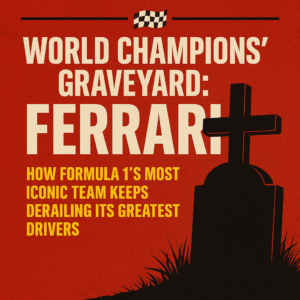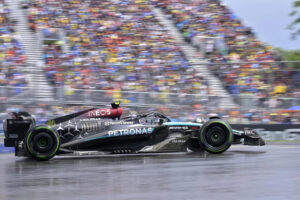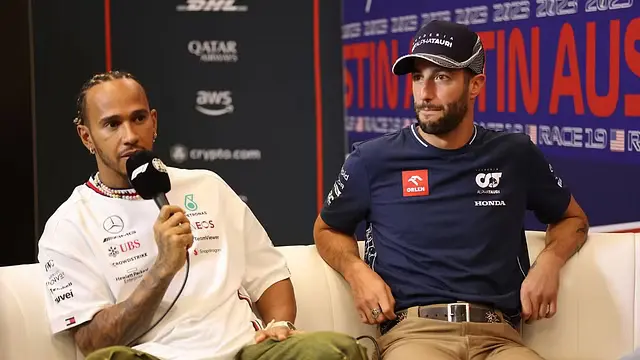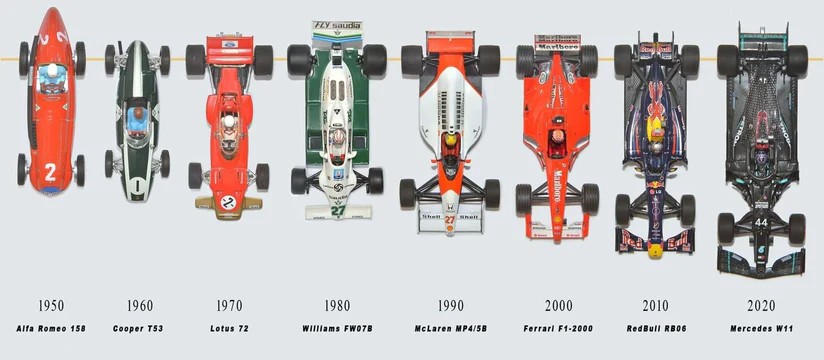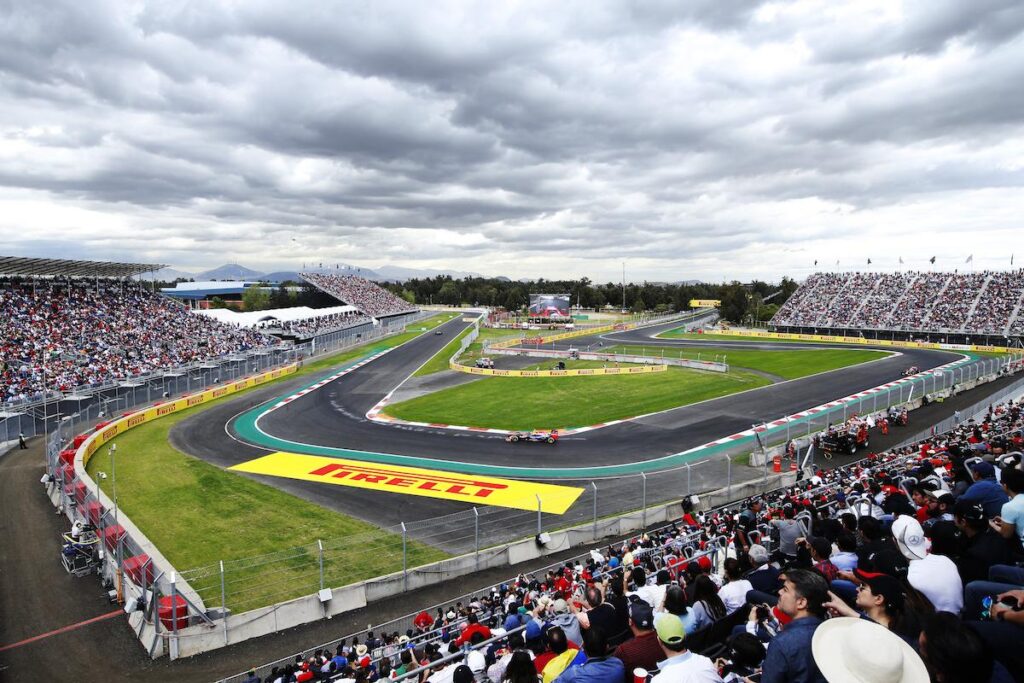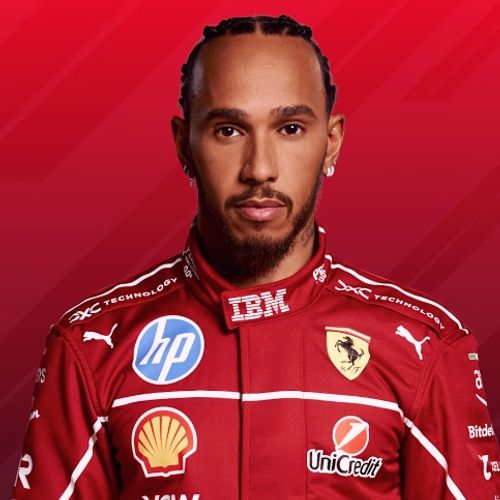
Full Name | Sir Lewis Carl Davidson Hamilton |
Date of Birth / Place of Birth | 7 January 1985 / Stevenage, Hertfordshire, England |
Nationality | British |
Race Number | 44 |
Current Status | Mercedes F1 Driver (2024) Scuderia Ferrari HP Driver (2025) |
Active Years in Formula 1 | 2007 – Present (18 Seasons) |
World Championships | 7 (Shared All-Time Record) |
Total F1 Races Started | 376 |
Total Wins | 105 (All-Time Record) |
Total Podiums | 202 (All-Time Record) |
Total Pole Positions | 104 (All-Time Record) |
Total Career Points | 5008.5 (All-Time Record) |
Lewis Hamilton is widely regarded as one of the most successful athletes in Formula 1 history, holding the joint record for World Drivers’ Championships and the outright records for race wins, pole positions, and podium finishes. His career spans nearly two decades, characterized by phenomenal success with McLaren and unparalleled dominance with Mercedes.
Early Life, Family Roots, and Foundational Passion
Lewis Carl Davidson Hamilton was born in Stevenage, Hertfordshire, England, on 7 January 1985. He grew up in a mixed-race family environment, with his father, Anthony Hamilton, serving as the critical pillar of support and initial manager for his burgeoning career.

The start of Hamilton’s racing life began at the age of eight, marking a profound financial turning point for the family. His father gifted him a used go-kart, an investment that reportedly cost approximately one month of the family’s income. This substantial sacrifice immediately established a high-stakes, win-or-fail environment. To fund this expensive passion, Anthony Hamilton often had to work three jobs simultaneously. When Lewis was not able to practice on an actual track, he displayed his dedication by diligently logging virtual laps on the computer racing simulator Grand Prix 2.
This intense early pressure, driven by personal sacrifice and high expectations, helped instill a unique discipline and resilience in the young driver. The environment cultivated a mentality where success was not merely a desirable outcome, but a necessity to continue pursuing his dream.
The McLaren Breakthrough
A pivotal moment occurred when Hamilton was just ten years old. He proactively approached Ron Dennis, the chief executive officer of the McLaren racing team, and expressed his ambition to race for McLaren one day. His remarkable performance during the 1996–97 karting season validated this promise.
In 1998, McLaren-Mercedes Benz officially signed Hamilton to its young driver support program. This endorsement was revolutionary, as it financially backed his ascent through the motorsport ranks, greatly relieving the intense financial burden that had rested entirely on his father. By joining the programme, Hamilton became the youngest driver ever signed by McLaren, confirming his status as an unprecedented prodigy in British motorsport.
The Road to Formula 1: The Prodigy’s Ascent
Hamilton’s progression from karting to Formula 1 was characterized by methodical dominance and a “clean sweep” of the feeder categories, supported entirely by the McLaren Junior Programme.
His early career included eight championships in six years of karting, securing multiple national and international titles. This stellar performance continued seamlessly into single-seater racing. He won the European Karting championship and the Formula UK Renault title.
In 2005, he became the British F3 Champion, a season widely noted for confirming his emergence as a “complete driver profile”. The consistent ability to perform across varied machinery and competitive formats suggests that his talent was innate and highly reliable, justifying the substantial investment made by McLaren years earlier.
GP2 Dominance and F1 Breakthrough
The final stop before Formula 1 was the highly competitive GP2 Series (now Formula 2) in 2006. Hamilton won the championship, achieving five victories in 21 starts, and quickly “rewired expectations” for what a rookie in the series could accomplish.
His time in GP2 was defined by spectacular racecraft and remarkable comebacks from deep in the field. The signature moment of his junior career—a move that encapsulates his confidence and technical skill—was a viral, late-braking, side-by-side, three-wide pass executed at Silverstone’s Maggots-Becketts corner at approximately 140 mph, overtaking Nelson Piquet Jr. and Clivio Piccione. This move demonstrated that his success was rooted in consistent, innate driving ability rather than reliance on specific car regulations or setups.
Following the definitive GP2 title, Hamilton’s promotion to Formula 1 was inevitable. For the 2007 season, he was placed alongside two-time defending World Champion Fernando Alonso at McLaren, marking one of the most anticipated rookie debuts in the sport’s history.
Formula 1 Career: Two Decades of Dominance and Transition
The McLaren Years (2007–2012)
Sir Lewis Hamilton made his Formula 1 debut at the Australian Grand Prix in 2007. His performance was immediately exceptional, delivering “one of the greatest rookie performances in F1 history”. He finished on the podium in his first race and secured four victories that year.

The 2007 season was immediately defined by the intense intra-team rivalry with teammate Fernando Alonso. The championship battle was so fierce that tension escalated rapidly, including an infamous incident where Alonso reportedly held up Hamilton in the pit lane after Hamilton allegedly ignored team orders. This rivalry became so taxing that both drivers ultimately missed out on the title by one point to Kimi Räikkönen. Alonso, unable to sustain the internal pressure, terminated his contract at the end of the campaign.
The following year, 2008, Hamilton secured his maiden World Championship in dramatic fashion at the season-ending Brazilian Grand Prix, becoming the youngest champion in F1 history at the time.
While the subsequent McLaren years saw Hamilton add several wins, the team began to struggle for consistency against the dominance of Red Bull Racing. This downturn led to Hamilton making a pivotal, high-risk decision to leave his lifelong team, McLaren, at the end of the 2012 season.
The Mercedes Era (2013–2024): The Hybrid Dynasty
In 2013, Hamilton made the visionary move to the Mercedes AMG Petronas F1 Team, a transition that coincided perfectly with the imminent introduction of the V6 turbo-hybrid regulations in 2014. This strategic timing allowed him to establish unprecedented dominance in the sport.
The Rosberg Conflict
The early Mercedes era was defined by a ruthless intra-team rivalry with his long-time friend and former junior racing rival, Nico Rosberg. Hamilton won the 2014 and 2015 titles, establishing early command of the new technical regulations. The conflict reached its climax in 2016 when Rosberg finally overcame Hamilton to win the championship. The intensity of this rivalry is demonstrated by Rosberg’s immediate retirement from the sport just days after securing the title, suggesting that competing directly with Hamilton for championships imposed an unsustainably high mental and emotional toll. This pattern—of teammates either leaving or retiring when paired with Hamilton—highlights his ability to maintain and thrive under extremely high internal competitive pressure.
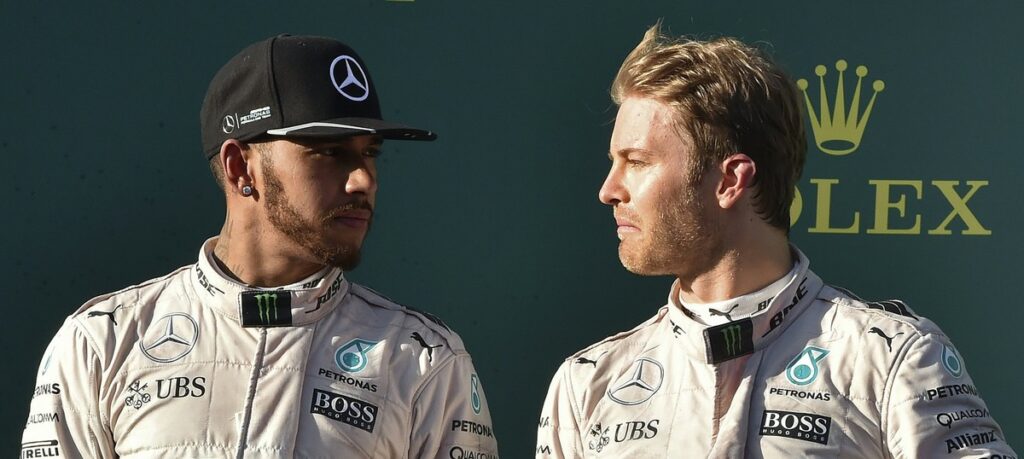
Record-Shattering Dominance
Following Rosberg’s departure, Hamilton achieved four consecutive World Championships from 2017 through 2020. During this period, he systematically dismantled the records set by previous legends. He surpassed his childhood hero Ayrton Senna on the all-time pole positions list and later surpassed Michael Schumacher in the wins column. By 2020, with his emotional victory at the Turkish Grand Prix, Hamilton matched Schumacher’s historic mark of seven World Championship titles.
The Epochal 2021 Rivalry
The 2021 season featured one of the most dramatic title battles in F1 history, fought fiercely with Max Verstappen of Red Bull Racing. The season was characterized by controversial moments, including on-track collisions at the British Grand Prix and in Monza.
The championship famously came down to the season-closing Abu Dhabi Grand Prix, with both drivers tied on points. Hamilton was on course to secure a record eighth title until a highly scrutinized late Safety Car procedure allowed Verstappen to pit for fresh Soft tires and overtake Hamilton on the final lap, securing the title.
Post-2021 Challenges and The Ferrari Chapter
The introduction of new ground-effect technical regulations in 2022 fundamentally shifted the competitive landscape. Mercedes’ W13 car struggled significantly with aerodynamic instability, including “porpoising and bouncing”. Hamilton faced a period of profound technical difficulty, enduring challenging weekends, such as finishes of 10th in Jeddah and 13th in Imola.
The 2022 season marked Hamilton’s first winless year in Formula 1, underscoring the severity of the car’s performance deficit. His teammate, George Russell, took the team’s only victory that year and marginally outscored Hamilton (275 points to 240).
Despite a poor 2023 season, Hamilton renewed his contract with Mercedes in August 2023 to compete in both the 2024 and 2025 seasons. However, in a shocking announcement in February 2024, it was confirmed that he would be leaving Mercedes early to join Scuderia Ferrari HP in 2025, partnering Charles Leclerc.
This transfer represents a pivotal, late-career bet. Having faced two seasons where his machine struggled against the new regulations, the Ferrari move is a strategic attempt to find a platform capable of challenging for a record eighth title. The move fulfills a career aspiration; Hamilton was quoted expressing his profound excitement about the future:
“DRIVING A SCUDERIA FERRARI HP CAR FOR THE FIRST TIME WAS ONE OF THE BEST FEELINGS OF MY LIFE”.
He ended his career chapter with Mercedes on a high note in 2024, securing victories at the British and Belgian Grands Prix, and accumulating 223 points.
Driving Style, Technical Nuance, and Athleticism
Sir Lewis Hamilton’s driving style is distinctive and a significant contributing factor to his longevity and success. Unlike drivers who rely on aggressive, sharp inputs, Hamilton’s style is defined by its exceptional smoothness and technical precision.
The Science of Tire Management
His greatest technical advantage behind the wheel is arguably his unparalleled tire management capability. Hamilton possesses an extraordinary capacity to maintain consistent lap times over long stints while minimizing degradation, effectively transforming tire management from a reactive exercise into a “proactive competitive weapon”.
This skill is achieved through a technical nuance characterized by microscopic input control. This involves:
- Smooth Steering Corrections: Minimizing lateral scrubbing and abrupt changes in direction.
- Precise Braking: Calculated brake applications that avoid overheating the compounds.
- Minimal Aggressive Acceleration: Utilizing throttle inputs to maximize traction rather than inducing wheelspin.
This high degree of mechanical empathy, coupled with minimal aggressive force application, is not only beneficial for tire life but also minimizes cumulative stress on the car’s components (engine, gearbox, suspension) over a season. This consistent preservation of his machinery contributes directly to his low career DNF count (only 33 in 376 races) , which is a critical, yet underrated, component of his statistical dominance and endurance at the highest level.
Adaptability and Wet-Weather Prowess
Hamilton also demonstrates exceptional adaptability, particularly in challenging conditions. His performances in wet-weather scenarios are legendary, showcasing an “extraordinary ability to read and respond to rapidly changing track dynamics”. Key examples, such as his dominating drive at the 2008 British Grand Prix and his masterful performance to secure the title at the 2020 Turkish Grand Prix, demonstrate his capacity to turn potentially disadvantageous situations into strategic opportunities.
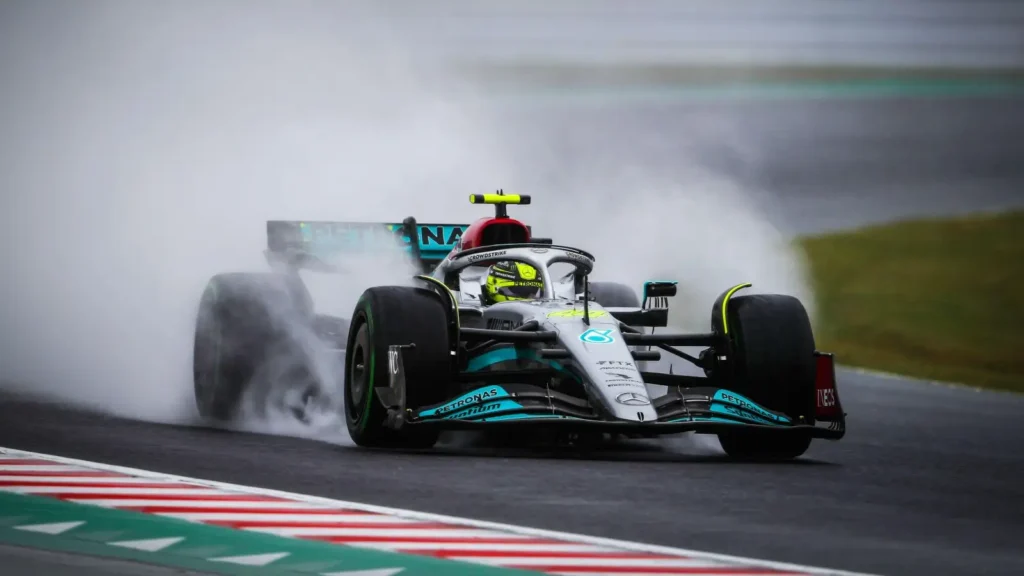
Furthermore, Hamilton is known for his deep technical comprehension, enabling him to collaborate closely with engineers on setup. He often makes nuanced setup adjustments to extract performance from machinery that might challenge less versatile drivers, effectively transforming “seemingly suboptimal cars into competitive platforms”.
Achievements, Records, and Formal Recognition
Sir Lewis Hamilton stands alone in several key statistical metrics in Formula 1 history. He holds or shares the records for seven World Championships, 105 race wins, 104 pole positions, and over 5,000 career points. His sustained excellence across two distinct F1 regulatory eras (V8 and V6 Hybrid) confirms his place at the apex of the sport.
Knighthood and Advocacy
In 2020, Hamilton received one of the highest honors in the United Kingdom, a knighthood, as part of Queen Elizabeth II’s New Year’s Honours list.
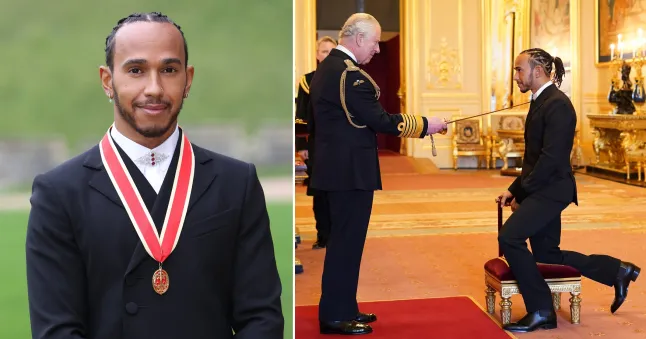
This recognition was distinct, honoring not only his services to motorsport but also his pivotal work as an advocate for diversity and equality. Hamilton leveraged his massive international platform during this period to advocate for change, stating that his success was partly inspired by the Black Lives Matter movement. He utilized the grid as a platform, “taking the knee on the grid and wor[ing] anti-racism slogans during the season”.
Hamilton himself has emphasized that the drive to utilize his platform against racism was a deeper motivator than success alone. The knighthood serves as a significant cultural statement, acknowledging the modern athlete’s social responsibility and transforming the honor from a purely sporting accolade into a cultural milestone recognizing his leadership in diversifying a historically exclusive sport.
It is noted that the knighthood was awarded in the “overseas” section of the honours list due to his residency in Monaco. While his tax affairs had previously drawn media attention, Motorsport U.K. Chairman David Richards publicly asserted that Hamilton’s tax status had been “totally misunderstood” and confirmed that the racing champion was one of the highest taxpayers in the U.K..
Career Statistics Summary
Hamilton’s statistical profile demonstrates not only sheer speed (104 Poles) but also exceptional consistency and race execution (202 Podiums, 105 Wins) across his 18 seasons in the sport.
Career Statistics Summary (2007–2024)
Statistic | Career Total |
Seasons Raced | 18 |
Teams Raced For | 2 (McLaren, Mercedes) |
Races Started/Entered | 376 |
World Championship Titles | 7 |
Race Wins | 105 |
Pole Positions | 104 |
Podiums | 202 |
Career Points | 5008.5 |
Highest Championship Finish | 1st (x7) |
Career DNFs | 33 |
The data reveals an extraordinary conversion rate: he has finished on the podium in over 53% of all races started and has won 27% of all races entered. This persistent accumulation of points over nearly two decades is the ultimate explanation for his massive career points tally, reinforcing the importance of his mechanically sympathetic driving style and focus on reliability over mere peak performance.
Personal Life, Activism, and Off-Track Endeavors
Lewis Hamilton’s public persona is marked by his commitments to social issues, sustainability, and personal growth. His personal philosophy is often summarized by the phrase ‘Still I Rise,’ a motto emblazoned across the back of his helmet and tattooed across his shoulders. This mantra reflects his journey of overcoming adversity, particularly the challenges he faced as a mixed-race person in a predominantly white sport.
Off the track, Hamilton is a highly visible figure with notable interests in high-end fashion, music, and his public advocacy for veganism and environmental causes. His family connections include his half-brother, Nicolas Hamilton, a successful racing driver in the British Touring Car Championship (BTCC).
Mission 44: The Architectural Legacy
Hamilton channeled his commitment to diversity into tangible action by founding Mission 44, a charitable organization. The organization is explicitly named after his racing car number, 44, serving as a powerful “reminder that it’s possible to succeed no matter what your background”.

The foundation’s mandate is rooted in Hamilton’s “first-hand experience of an education system that worked against him”. His success as the only person of color in his field has driven him to build a fairer, more inclusive future for young people globally.
Mission 44 operates on three core pillars aimed at systemic change :
- Inclusive Education: Building equitable educational systems where every young person is supported to succeed.
- STEM Employment: Creating accessible career opportunities for underrepresented youth in Science, Technology, Engineering, and Mathematics (STEM) fields, particularly within motorsport itself.
- Youth Empowerment: Empowering young people to take action and actively shape the world they live in.
By financially and strategically backing innovators and system-changers in these areas, Mission 44 functions as an institutional counterweight to the systemic barriers Hamilton faced. This work ensures that his influence on motorsport is structural, guaranteeing that his legacy will persist in creating a more diverse professional pipeline long after his driving career concludes.
Legacy, Public Image, and Cultural Impact
Sir Lewis Hamilton’s legacy is complex, encompassing both his statistical dominance and his role as a cultural and social trailblazer.
The Greatest of All Time (G.O.A.T) Conversation
Based purely on unprecedented statistics—including most wins, poles, and championships—Hamilton has permanently secured his place in the “Greatest of All Time” (G.O.A.T) conversation. His ability to maintain sustained excellence across two major technical eras, and his success in defeating two of the sport’s most fiercely competitive teammates (Alonso and Rosberg), underscores his versatility and mental fortitude.
The most profound measure of his legacy is perhaps his ability to surpass the records of his hero, Ayrton Senna, on the pole positions list, and then overtake Michael Schumacher’s benchmarks for race wins and world titles.
A Cultural Trailblazer
Beyond the statistics, Hamilton’s public image is intrinsically tied to his advocacy. His willingness to use his global platform to promote diversity, racial equality, and environmental consciousness marks a significant evolution in the role of the modern sporting superstar. He has actively worked to ensure that his career is not seen as an isolated success story, but as a catalyst for broadening participation in the sport.
His defining career moments often intertwine professional and personal triumph, such as the emotional 2020 Turkish Grand Prix victory to clinch his seventh title, a success he attributed partly to the activist movement he championed. Furthermore, the dramatic 2025 move to Ferrari—the team that represents the romantic and historical heart of the sport—injects a powerful narrative into his final chapter, highlighting his relentless pursuit of the next goal: the record eighth title.
Fun Facts
Did You Know?
- The Number 44: Lewis Hamilton uses the race number 44, which he adopted from the license plate of his father’s car when he first started karting. The number is the namesake of his charitable foundation, Mission 44.
- A Priceless Start: His first competitive go-kart was a used model, gifted by his father, that cost the family approximately one month’s worth of income.
- Knighthood Status: Following his record-equalling seventh World Championship in 2020, he officially became “Sir Lewis Hamilton”.
- The Ultimate Rivalry: His F1 debut came alongside two-time defending champion Fernando Alonso in 2007, an immediate pairing that resulted in one of the most volatile intra-team rivalries in history.
- Personal Philosophy: His personal mantra, ‘Still I Rise,’ is tattooed across his shoulders and featured on his helmet.
The Ferrari Aspiration: Hamilton described driving the Scuderia Ferrari HP car for the first time as “one of the best feelings of my life” , confirming the high personal significance of his 2025 move.
Sir Lewis Hamilton — Formula 1 Profile, Stats, and Career History
Sir Lewis Hamilton Full Name Sir Lewis Carl Davidson Hamilton...
Read MoreWorld Champions’ Graveyard: Ferrari
How Formula 1’s Most Iconic Team Keeps Derailing Its Greatest...
Read MoreLewis Hamilton: A Fashion Icon and Advocate at the Met Gala
Lewis Hamilton, the seven-time Formula 1 world champion, has been...
Read MoreHow F1 Drivers Reacted to Daniel Ricciardo’s Exit as Lewis Hamilton Calls Him a ‘Legend’
Daniel Ricciardo’s time in Formula 1 looks to be coming...
Read MoreBearman Buzzes About Hamilton’s Ferrari Move
Oliver Bearman, the young British racing star set to make...
Read MoreMercedes’ Belgian Grand Prix Miracle: Unpacking the Transformation
The 2024 Belgian Grand Prix was a stark contrast of...
Read More

